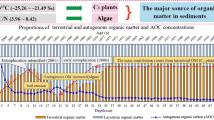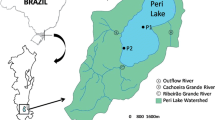Abstract
Sediment cores were collected from the central and northern parts of Lake Dianchi, a large and shallow eutrophic lake situated in southwest China. Total organic carbon, total nitrogen (TN), and total phosphorus (TP) as well as the δ13C and δ15N were analyzed in the sediment cores. Age model of the sediment cores were established according to 137Cs geochronology, which reveals that the sedimentary record covers a period of the last 50 years. During that time, Dianchi had been undergoing a distinct conversion from oligotrophic to eutrophic, as a result of increasing nutrient loadings. The two cores displayed similar increases for values of TN and δ15N, and the variations of the both parameters matched well with that of TP, which presumably suggested that δ15N is a reliable proxy for anthropogenic nutrient input. Also, dynamics of δ15N and TP showed that anthropogenic nutrients input seemed to start in the 1970s. The upward elevation of δ15N might be ascribed to the increasing input of isotopically heavier dissolved inorganic nitrogen and the accelerated denitrification process when the lake water was oxygen-depleted. The less variation of δ15N in the uppermost several centimeters of both cores were probably the result of pollution controls carried out by the local government in the recent decade. The upward increasing of δ13C in the two cores seemed to be induced by the enhanced productivity since 1980, which was in accordance with limnological observation. Therefore, δ13C values were believed to be an effective proxy for reconstructing the history of eutrophication in Lake Dianchi. In addition, this study also suggested that carbon and nitrogen isotopes are applicable to large, shallow lakes in interpreting the past environmental change.






Similar content being viewed by others
References
Altabet, M. A., Pilskaln, C., Thunell, R., Pride, C., Sigman, D., Chavez, F., et al. (1999). The nitrogen isotope biogeochemistry of sinking particles from the margin of the Eastern North Pacific. Deep-Sea Research. Part I, Oceanographic Research Papers, 46, 655–679. doi:10.1016/S0967-0637(98)00084-3.
Ellegaard, M., Clarke, A. L., Reuss, N., Drew, S., Weckström, K., Juggins, S., et al. (2006). Multi-proxy evidence of long-term changes in ecosystem structure in a Danish marine estuary, linked to increased nutrient loading. Estuarine, Coastal and Shelf Science, 68, 567–578. doi:10.1016/j.ecss.2006.03.013.
Fogel, M. L., & Cifuentes, L. A. (1993). Isotope fractionation during primary production. In M. H. Engel, & S. A. Macko (Eds.), Organic geochemistry (pp. 73–98). New York: Plenum.
Francois, R., Altabet, M. A., & Burckle, L. H. (1992). Glacial to interglacial changes in surface nitrate utilization in the Indian sector of the Southern Ocean as recorded by sediment δ15N. Paleoceanography, 7, 589–606. doi:10.1029/92PA01573.
Freudenthal, T., Wagner, T., Wenzhöfer, F., Zabel, M., & Wefer, G. (2001). Early diagenesis of organic matter from sediments of the eastern subtropical Atlantic: Evidence from stable nitrogen and carbon isotopes. Geochimica et Cosmochimica Acta, 65(11), 1795–1808. doi:10.1016/S0016-7037(01)00554-3.
Freyer, H. D., & Aly, A. I. (1974). Nitrogen-15 variations in fertilizer nitrogen. Journal of Environmental Quality, 3, 405–406.
Gao, L., Yang, H., Zhou, J., & Lu, J. (2004). Lake sediments from Dianchi Lake: A phosphorus sink or source. Pedosphere, 14(4), 483–490.
Gao, L., Zhou, J., Yang, H., & Chen, J. (2005). Phosphorus fractions in sediment profiles and their potential contributions to eutrophication in Dianchi Lake. Environmental Geology, 48, 835–844. doi:10.1007/s00254-005-0005-3.
Gray, A. V., & Li, W. (1999). Case study on water quality modelling of Dianchi Lake, Yunnan province, South West China. Water Science and Technology, 40(2), 35–43. doi:10.1016/S0273-1223(99)00428-X.
Hayes, J. M. (1993). Factors controlling 13C contents of sedimentary organic compounds: Principles and evidence. Marine Geology, 113, 111–125. doi:10.1016/0025-3227(93)90153-M.
Heaton, T. H. E. (1986). Isotopic studies of nitrogen pollution in the hydrosphere and atmosphere: A review. Chemical Geology, 59, 87–102. doi:10.1016/0009-2541(86)90046-X.
Hodell, D. A., & Schelske, C. L. (1998). Production, sedimentation, and isotopic composition of organic matter in Lake Ontario. Limnology and Oceanography, 43(2), 200–214.
Hu, J., Liu, Y., & Liu, J. (2006). The comparison of phosphorus pools from the sediment in two bays of lake Dianchi for cyanobacterial bloom assessment. Environmental Monitoring and Assessment, 121, 1–14. doi:10.1007/s10661-005-9036-1.
Jin, X. C. (2003). Experience and Lessons Learned Brief for Lake Dianchi. http://www.worldlakes.org/uploads/Dianchi_12.26.03.pdf
Lehmann, M. F., Bernasconi, S. M., Barbieri, A., & Mckenzie, J. A. (2002). Preservation of organic matter and alteration of its carbon and nitrogen isotope composition during simulated and in situ early sedimentary diagenesis. Geochimica et Cosmochimica Acta, 66(20), 3573–3584. doi:10.1016/S0016-7037(02)00968-7.
Leng, M. J., & Marshall, J. D. (2004). Palaeoclimate interpretation of stable isotope data from lake sediment archives. Quaternary Science Reviews, 23, 811–831. doi:10.1016/j.quascirev.2003.06.012.
Lü, J., Yang, H., Gao, L., & Yu, T. (2005). Spatial variation of P and N in water and sediments of Dianchi Lake, China. Pedosphere, 15(1), 78–83.
Meyers, P. A. (1997). Organic geochemical proxies of paleoceanographic, paleolimnologic, and paleoclimatic processes. Organic Geochemistry, 27(5/6), 213–250. doi:10.1016/S0146-6380(97)00049-1.
Minigawa, M., & Wada, E. (1984). Stepwise enrichment of 15N along food chains: Further evidence and the relation between δ15N and animal age. Geochimica et Cosmochimica Acta, 48, 1135–1140. doi:10.1016/0016-7037(84)90204-7.
Müller, A., & Voss, M. (1999). The palaeoenvironments of coastal lagoons in the southern Baltic Sea, II. δ13C and δ15N ratios of organic matter—sources and sediments. Palaeogeography, Palaeoclimatology, Palaeoecology, 145, 17–32. doi:10.1016/S0031-0182(98)00095-9.
Muzuka, A. N. N., Ryner, M., & Holmgren, K. (2004). 12,000-Year, preliminary results of the stable nitrogen and carbon isotope record from the Empakai Crater lake sediments, Northern Tanzania. Journal of African Earth Sciences, 40, 293–303. doi:10.1016/j.jafrearsci.2004.12.005.
Neumann, T., Stogbauer, A., Walpersdorf, E., Stuben, D., & Kunzendorf, H. (2002). Stable isotopes in recent sediments of Lake Arendsee, NE Germany: Response to eutrophication and remediation measures. Palaeogeography, Palaeoclimatology, Palaeoecology, 178, 75–90. doi:10.1016/S0031-0182(01)00403-5.
Ogrinc, N., Fontolan, G., Faganeli, J., & Covelli, S. (2005). Carbon and nitrogen isotope compositions of organic matter in coastal marine sediments (the Gulf of Trieste, N Adriatic Sea): Indicators of sources and preservation. Marine Chemistry, 95, 163–181. doi:10.1016/j.marchem.2004.09.003.
O’Reilly, C. M., Dettman, D. L., & Cohen, A. S. (2005). Paleolimnological investigations of anthropogenic environmental change in Lake Tanganyika: VI. Geochemical indicators. Journal of Paleolimnology, 34, 85–91. doi:10.1007/s10933-005-2399-z.
Peters, K. E., Sweeney, R. E., & Kaplan, I. R. (1978). Correlation of carbon and nitrogen stable isotope ratios in sedimentary organic matter. Limnology and Oceanography, 23, 598–604.
Schelske, C. L., & Hodell, D. A. (1991). Recent changes in productivity and climate of Lake Ontario detected by isotopic analysis of sediments. Limnology and Oceanography, 36(5), 961–975.
Schelske, C. L., & Hodell, D. A. (1995). Using carbon isotopes of bulk sedimentary organic matter to reconstruct the history of nutrient loading and eutrophication in Lake Erie. Limnology and Oceanography, 40(5), 918–929.
Sigman, D. M., Altabet, M. A., Francois, R., McCorkle, D. C., & Gaillard, J. F. (1999). The isotopic composition of diatom-bound nitrogen in Southern Ocean sediments. Paleoceanography, 14, 118–134. doi:10.1029/1998PA900018.
Struck, U., Emeis, K. -C., Voss, M., Christiansen, C., & Kunzendorf, H. (2000). Records of southern and central Baltic Sea eutrophication in δ13C and δ15N of sedimentary organic matter. Marine Geology, 164, 157–171. doi:10.1016/S0025-3227(99)00135-8.
Sweeney, R. E., & Kaplan, I. R. (1980). Natural abundance of 15N as a source indicator for near-shore marine sedimentary and dissolved nitrogen. Marine Chemistry, 9, 81–94. doi:10.1016/0304-4203(80)90062-6.
Verburg, P. (2007). The need to correct for the Suess effect in the application of δ13C in sediment of autotrophic Lake Tanganyika, as a productivity proxy in the Anthropocene. Journal of Paleolimnology, 37, 591–602. doi:10.1007/s10933-006-9056-z.
Voss, M., Larsen, B., Leivuori, M., & Vallius, H. (2000). Stable isotope signals of eutrophication in Baltic Sea sediments. Journal of Marine Systems, 25, 287–298. doi:10.1016/S0924-7963(00)00022-1.
Voss, M., & Struck, U. (1997). Stable nitrogen and carbon isotopes as indicator of eutrophication of the Oder river (Baltic Sea). Marine Chemistry, 59, 35–49.
Wan, G., Bai, Z., Liu, T., et al. (2001). The differentials of fallout 137Cs between western Yunan and central Guizhou: Implication for the barrier effect of Qinghai–Xizhang uplift on global atmospheric pollutants in Yunan–Guizhou plateau. Quaternary Sciences, 21(5), 407–415.
Wang, Y. C., Huang, R. G., & Wan, G. J. (1998). A newly developed sampler for collecting samples near lacustrine sediments–water interface. Geology-Geochemistry, 1, 94–96 (in Chinese with English abstract).
Whitmore, T. J., Brenner, M., Jiang, Z., Curtis, J. H., Moore, A. M., Engstrom, D. R., et al. (1997). Water quality and sediment geochemistry in lakes of Yunnan Province, southern China. Environmental Geology, 32(1), 45–55.
Xu, H., Ai, L., Tan, L., & An, Z. (2006). Stable isotopes in bulk carbonates and organic matter in recent sediments of Lake Qinghai and their climatic implications. Chemical Geology, 235, 262–275.
Yamamuro, M., & Kanai, Y. (2005). A 200-year record of natural and anthropogenic changes in water quality from coastal lagoon sediments of Lake Shinji, Japan. Chemical Geology, 218, 51–61.
Yu, G. Y., Liu, Y. D., Qiu, C. Q., & Xu, X. Q. (2000). Macrophyte succession in Dianchi Lake and relations with the environment. Journal of Lake Science, 12(1), 73–80 (in Chinese with English abstract).
Zhang, Y., Peng, B. Z., Chen, J., & Lu, J. J. (2005). Evaluation of sediment accumulation in Dianchi Lake, using 137Cs dating. Acta Geographica Sinica, 60(1), 71–78 (in Chinese with English abstract).
Acknowledgements
We thank Dr. Lei Gao for his careful assistance in improving the quality of language in this paper. This research was funded by the National Basic Research Program of China (973 Program) (No. 2006CB403205), the National Natural Science Foundation of China (No. 40571158), Shanghai Rising-Star Program (08QA14029), and the Shanghai Education Committee and the Shanghai Leading Academic Disciplines (T0105).
Author information
Authors and Affiliations
Corresponding author
Electronic supplementary material
Below is the link to the electronic supplementary material.
Appendix A
People’s Republic of China: Water Quality Classification System (GB3838-88) (DOC 25.5 KB).
Appendix B
Hydrological and geochemical features of Lake Dianchi (data from http://www.lake.csdb.cn/) (DOC 36.5 KB).
Rights and permissions
About this article
Cite this article
Wang, F., Liu, C., Wu, M. et al. Stable Isotopes in Sedimentary Organic Matter from Lake Dianchi and their Indication of Eutrophication History. Water Air Soil Pollut 199, 159–170 (2009). https://doi.org/10.1007/s11270-008-9868-8
Received:
Accepted:
Published:
Issue Date:
DOI: https://doi.org/10.1007/s11270-008-9868-8




